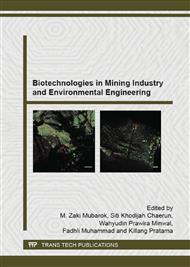p.560
p.564
p.568
p.572
p.577
p.581
p.585
p.589
p.594
Ruthenium Recovery from Acetic Acid Waste Solution by Using PEI-Coated Biomass-Chitosan Composite Fiber
Abstract:
Polyethylenimine (PEI)-coated biomass-chitosan composite fiber (PBCF) was fabricated to recover Ru from acetic acid waste solution. The present work aimed to understand the effects of molecular weight of chitosan and drying method on stability and sorption performance of the PBCF. For this, the PBCF was prepared by extruding the mixed solutions of chitosan and Corynebacterium glutamicum to form the composite fibers which were modified with ionic polymer, PEI. The degree of swelling of PBCFs prepared by hot-air, natural, and freeze drying methods were 1.25, 1.34, and 1.07 %, respectively, indicating that the freeze-drying method was the best. Batch biosorption studies showed that the maximum Ru uptake could be achieved with PBCF prepared with medium molecular weight chitosan, and could reach 34.1 mg/g, which was 7.9 times higher than that of the commercial ion exchange resin, LEWATIT® MonoPlus M 500 (4.3 mg/g). Therefore, PBCF can be considered as an alternative sorbent to synthetic resin for recovery of Ru form industrial acetic acid waste solution.
Info:
Periodical:
Pages:
577-580
Citation:
Online since:
November 2015
Authors:
Keywords:
Price:
Сopyright:
© 2015 Trans Tech Publications Ltd. All Rights Reserved
Share:
Citation:


